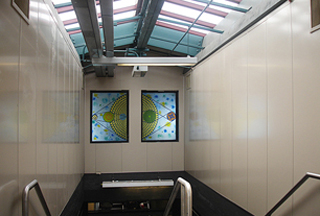4 Train Line Burnside Avenue Station
Burnside Avenue
Laura Battle How to Get to the Moon, 2006 faceted glass in platform windscreens MTA Arts for Transit |
 |
The images of the faceted glass windscreens at the Burnside Avenue Station are meant to link the universe with wheels-in-motion through forms and structures common to both. Windows in an elevated station present a unique opportunity for the subway rider to look out and up. When creating these windows, the artist considered the great windows throughout the history of architecture such as the rose window, which dramatically and spiritually embellished architectural spaces with its symmetry and luminous color. She considered the sun, its circle looming large. She considered wheels, and finally, the geometries of circles as a way to link planetary orbs and wheels—timeless in form and an important consideration for any permanent work of art. We look to the orbit of the planets around the sun to understand night and day. We leave in the morning, we return at night. Motors, industry, and ultimately transportation itself were no doubt born out of this singular encounter between man and sphere.
Influenced by a mosaic floor pattern from the terrace at the Piazza Campodiglio in Rome designed by Michaelangelo, the artist, Laura Battle included round, oculus designs in her work. Sensing how much the Burnside Avenue Station longed for color, she quickly arrived at blues and yellows for their uplifting juxtaposition and their reference to day and night.
Commuters hurrying to a train or coming home from a long day at work can pause for a moment or two to look at these windows. Their spirits will rise and for a brief time, they will be transported to another place to enjoy the timeless geometries found in the cosmos.
[More about Laura Battle]
[More about the MTA]
[Visit the MTA Arts for Transit website]
Influenced by a mosaic floor pattern from the terrace at the Piazza Campodiglio in Rome designed by Michaelangelo, the artist, Laura Battle included round, oculus designs in her work. Sensing how much the Burnside Avenue Station longed for color, she quickly arrived at blues and yellows for their uplifting juxtaposition and their reference to day and night.
Commuters hurrying to a train or coming home from a long day at work can pause for a moment or two to look at these windows. Their spirits will rise and for a brief time, they will be transported to another place to enjoy the timeless geometries found in the cosmos.
[More about Laura Battle]
[More about the MTA]
[Visit the MTA Arts for Transit website]